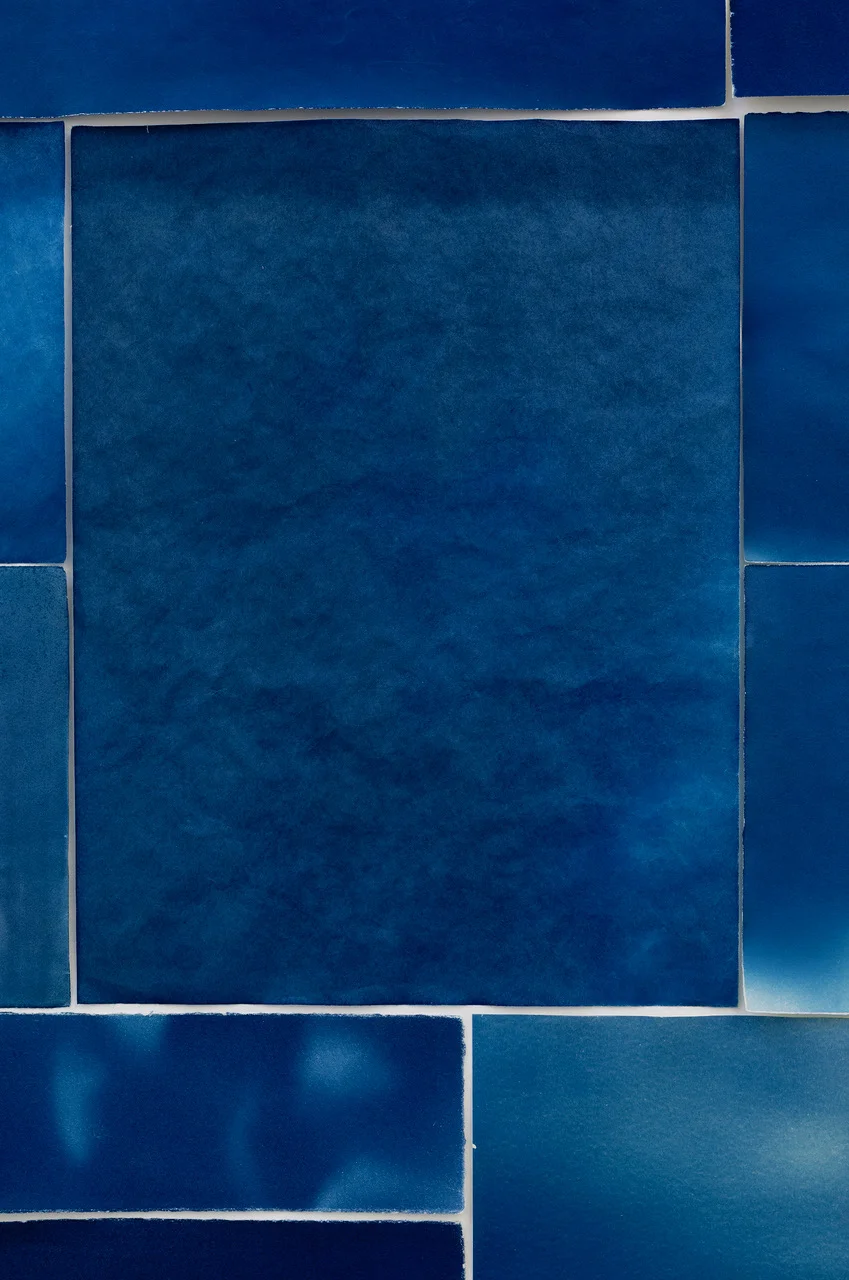Notes from the darkroom
/John Stezaker, Pair XXVII, 2015, collage, 20.3 x 24.2cm; image courtesy the artist and The Approach, London
While editing Photofile magazine in 2013, I vividly remember a Skype interview with the London artist John Stezaker, whose signature film-still collages were soon to appear at the 19th Biennale of Sydney. ‘I think of my collages as violations,’ he said, ‘and there is a violence, especially in my earlier ones.’ Active since the 1970s, and most recently with the moving image, Stezaker’s oeuvre (currently showcased in a City Gallery Wellington touring exhibition at the Centre for Contemporary Photography in Melbourne until 11 November) has been moving towards ‘a kind of act of reparation,’ he said, ‘bringing together, of healing in a way, so healing the divisions between male and female.’
Utako Shindo,Ode to the Zephyr’s murmuring petal, 2018, detail; cyanotype print on paper, 99 x 181cm; image courtesy the artist and Sutton Gallery, Melbourne
Since moving down the hill to a smaller, more grassroots space in Sydney, the Australian Centre for Photography has been rebuilding its artistic networks from the ground up. An annually exhibited ‘conversation’ between an Australian and an international artist has been part of this endeavour. With ‘Geography of Space, Archaeology of Time’ (26 October – 1 December), this year’s artists Izabela Pluta and Utako Shindo are natural conversationalists. Each has experienced displacement (Warsaw-born Pluta currently resides in Sydney; Shindo lives between Tokyo and Melbourne), and in this exhibition they behold a sense of place that is poetic and conceptual rather than geographically fixed.
David Goldblatt, Concession store (shop catering especially to Black miners), interior, Crown Mines, May 1967, 1967, silver gelatin photograph on fibre-based paper; image courtesy the artist and Goodman Gallery, Johannesburg and Cape Town; © the artist
The connection with Australia is not immediately apparent in the work of David Goldblatt (1930 – 2018), who for over 50 years documented the racial fault lines of his native South Africa, seeing them unravel through the fall of apartheid, with a patient, probing eye. But, as revealed in the first major Southern Hemisphere retrospective of Goldblatt’s photography (at Sydney’s Museum of Contemporary Art Australia, 19 October – 3 March 2019), there are many surprising parallels, including his documentation of asbestos mining at Wittenoom in Western Australia. Photography is also powerfully present in the MCA’s ‘Primavera 2018’ (9 November – 3 February 2019), including the lens-based work of Hayley Millar-Baker and Andrew Tenison.
Drew Pettifer, Mapping the interior: In search of an inland sea, 2013, video still; three-channel HD video, 18mins duration; image courtesy the artist
With its stark beauty, Gun Island off the coast of Western Australia at Geraldton is pregnant with photographic possibility. Not only is it the shipwreck site of the Dutch ship Zeewijkin 1727, but the place of one of Australia’s first known European trials – when two young Dutchmen were sentenced to death for sodomy and abandoned without rations to nearby islands. It is an intriguing and haunting narrative that draws the Melbourne-based photomedia artist Drew Pettifer to the Perth Institute of Contemporary Arts in November this year to further his ongoing research into such overlooked traces of queer history.
Hendrik Kerstens, Doily, 2011, ultrachrome print, 62.5 x 50cm; image courtesy the artist
Across the Australian continent from Gun Island can be found a different, enduring sign of Dutch influence. Supported by the Dutch Diplomatic Missions in Australia, ‘Erwin Olaf and Hendrik Kerstens’ (at Cairns Art Gallery until 7 October) brings together two otherwise contrasting Amsterdam-based photographers. While Olaf is the master of the outré mise en scène (including, most recently, his commissioned portraits of the Dutch royal family), Kerstens’s style is more retiring – confined as he has been to care for his daughter Paula since the mid-1990s, who is the subject of his tender and intimate Vermeer-inspired portraits.
Julie Rrap, Breath stream, 2018, pigment inkjet print, hand-ground glass, 66 x 116cm; image courtesy the artist, Arc One Gallery, Melbourne, and Roslyn Oxley9 Gallery, Sydney
Australian photography’s award season is upon us. Launched by Melbourne’s Monash Gallery of Art Foundation in 2006 to provide an annual platform for contemporary practice at ‘the Australian home of photography’, the William and Winifred Bowness Photography Prize (until 18 November) continues to push boundaries in the medium. This year size restrictions were removed for entries, allowing large-scale work for the first time, with shortlisted artists also including the performative (Julie Rrap) and the cameraless (Justine Varga). To be chosen by judges Michael Brand, Anouska Phizacklea and David Rosetzky, the winner will be announced on 11 October.
Justine Varga, Marking time, 2015–16, from ‘Memoire’, type-C photograph, 141 x 115cm; image courtesy the artist and Hugo Michell Gallery, Adelaide; recipient of the 2016 Josephine Ulrick and Win Schubert Photography Award
Polly Borland, Anne Ferran, Polixeni Papapetrou: past recipients of the Josephine Ulrick and Win Schubert Photography Award (JUWSPA) have helped define the idiom of Australian photographic practice. Founded in 2002 at the former Gold Coast City Gallery, recently rebranded Gallery at HOTA (Home of the Arts) ahead of its redevelopment, the JUWSPA’s top AU$25,000 acquisition award is matched by a similar amount for further acquisitions from the shortlisted works, ensuring the gallery’s collection is one of the most formidable in the country. To be selected by the Australian Centre for Photography’s Director and CEO Cherie McNair, this year’s winner will be announced at the 19 October opening, with the exhibition running until 25 November.
Article by Michael Fitzgerald from Art Monthly’s October issue 311
Purchase the October issue at http://www.artmonthly.org.au/single-issue-purchase






















